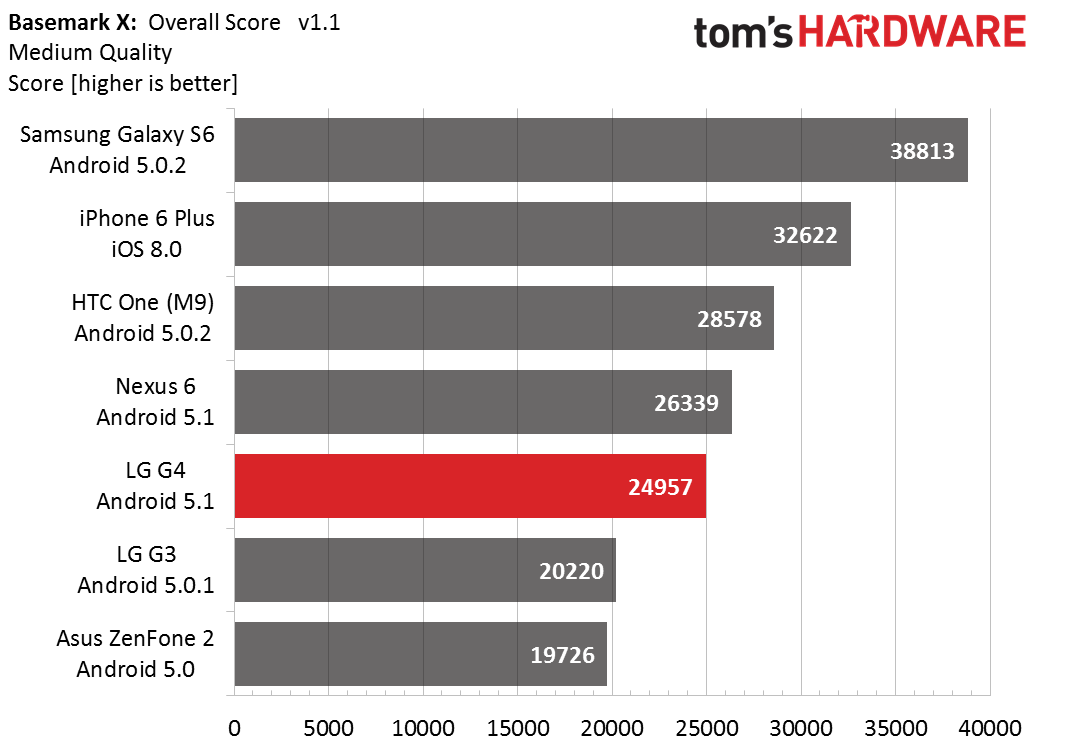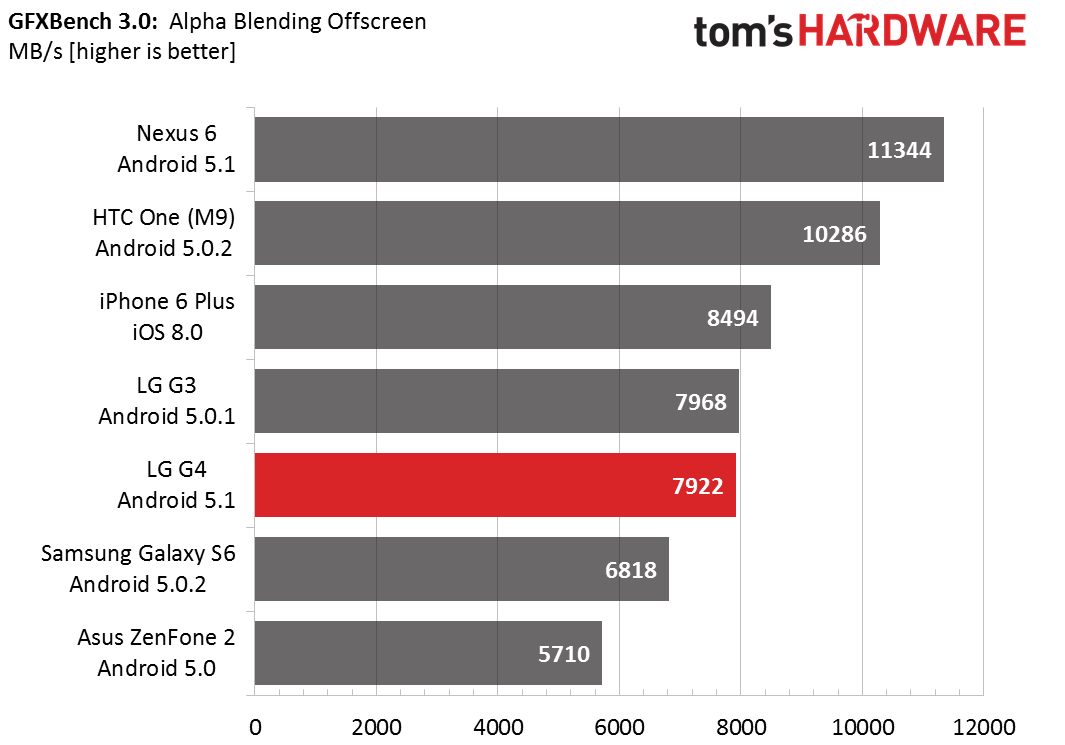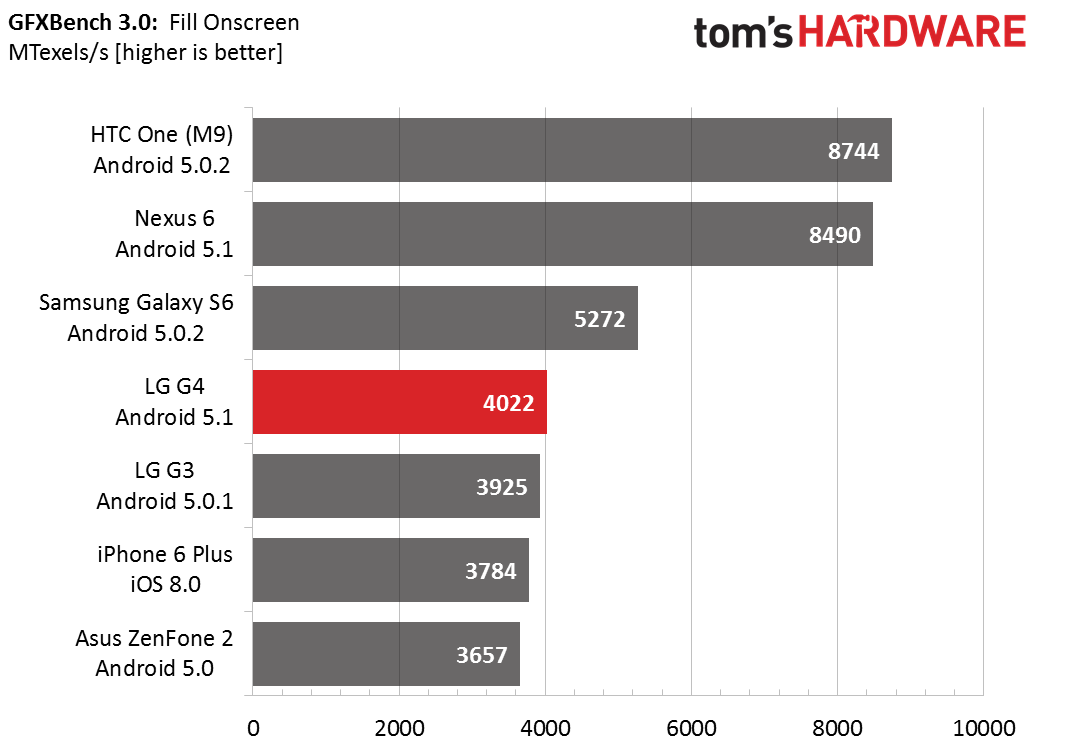LG G4 Review
The LG G4 retains a familiar look and still packs a removable battery and microSD slot, but it receives several internal upgrades, including a Snapdragon 808 SoC, an all-new camera, and a QHD IPS Quantum Display.
Why you can trust Tom's Hardware
GPU And Gaming Performance
Mobile GPU performance is becoming increasingly important as people begin to see their phones and tablets as portable gaming machines. This section explores GPU performance with several synthetic and real-world game engine tests. To learn more about how these benchmarks work, what versions we use, or our testing methodology, please read our article about how we test mobile device GPU performance.
The LG G4 does well in 3DMark Ice Storm Unlimited, almost equaling the graphics performance of the Galaxy S6 and iPhone 6 Plus. The G4’s Adreno 418 GPU gives it a 31% boost over the G3 too.
Since we know very little about the Adreno GPU architecture, and even less about the 418 in particular, let’s take a moment to compare the performance progression across several generations.
| Adreno GPU Performance Comparison (3DMark: Ice Storm Unlimited) | ||||
|---|---|---|---|---|
| Adreno GPUs* | 330 | 418 | 420 | 430 |
| Graphics Test 1 | 57.8% | 69.5% | 74.5% | 100% |
| Graphics Test 2 | 50.8% | 71.3% | 81.3% | 100% |
| * 330 (LG G3), 418 (LG G4), 420 (Galaxy Note 4), 430 (HTC One M9) |
Qualcomm has focused on improving pixel shading performance for a few generations now, optimizing and adding ALUs with each process shrink. We can see the fruits of its labor in the results for the second graphics test that focuses heavily on pixel operations by including particles and several post-processing effects. The Adreno 420 sees a significant performance increase over the 330, partially from the ALU improvements and partially from its optimized ROPs. Like the product numbering suggests, the 418’s performance is close to the 420.
The first graphics test focuses on vertex operations, with minimal pixel processing. Again we see steady but less significant performance improvements, with an even smaller delta between the 418 and 420. While the Adreno GPUs hold an advantage over ARM’s Mali GPU architecture in ALU performance—the G4 performs slightly better than the Galaxy S6 in the second graphics test—the Mali-T760MP8 GPU in the S6 outperforms both the Adreno 418 and 420 when it comes to vertex processing.
The physics test focuses on CPU performance and uses a data structure that requires random memory access patterns. Just like we saw in the AndEBench memory latency test, both the Snapdragon 808 and 810 in the G4 and M9, respectively, perform poorly. This seems to confirm that the memory controllers in the latest Snapdragon SoCs are optimized for sequential accesses like the A8 in the iPhone 6.



At the medium quality setting, the G4 sees a 23% gain over the G3 when rendering offscreen. When rendering at its native resolution, however, its advantage over the G3 drops to about 9%. It looks like the G4’s Adreno 418 GPU is running into a memory bandwidth limitation—both the G4 and G3 use the same LPDDR3-933 memory (14.9 GB/s)—and it’s unable to fully utilize its additional ALU resources.
Get Tom's Hardware's best news and in-depth reviews, straight to your inbox.



The G4 increases its offscreen rendering advantage over the G3 to 37% at the high quality setting. Larger texture and L2 caches were a couple of the improvements Qualcomm made to the Adreno 420 GPU. Based on these results, it looks like the 418 GPU in the G4 retains these enhancements, since it handles the larger textures better than the 330 GPU in the G3.
While the G4 is still faster than the older G3 and cheaper ZenFone 2, it cannot compete with the current flagship phones in this test. The higher resolution textures in this test require more memory bandwidth, something the Galaxy Note 4 (not shown) has 70% more of, giving it a 42% lead over the G4.


GFXBench Manhattan uses an OpenGL ES 3.0 based game engine. With an abundance of lighting and pixel effects, we’d expect the Adreno 430 in the M9 to pull ahead of the pack, but instead, it falls behind the Galaxy S6 when rendering offscreen at 1080p. The LG G4 shows a decent performance increase over the G3, but trails the Nexus 6 by a wider than expected margin.
Manhattan uses deferred rendering for its lighting effects, which is highly dependent on screen resolution. It’s no surprise then to see the phones with QHD screens take a performance hit when rendering at their native resolution, allowing the 1080p M9, iPhone 6 Plus, and ZenFone 2 to improve their positions in the chart. The Adreno GPUs in the G3, G4, and Nexus 6 all show a 30% to 37% performance deficit when rendering onscreen.


The more balanced rendering pipeline in the OpenGL ES 2.0 based T-Rex game simulation allows the G4 to close the gap with the Nexus 6 and extend its lead over the G3 to 43% when rendering offscreen. The Galaxy S6, however, is 56% faster than the G4 and is the overall performance leader in T-Rex.









The GFXBench Alpha Blending test stresses rasterization and memory bandwidth. In both offscreen and onscreen rendering, the LG G4 achieves the same throughput as the G3 and significantly less than the Nexus 6. The Fill test, which stresses pixel processing and memory bandwidth, shows the same pattern: The G4 and G3 deliver the same performance onscreen and offscreen. These tests certainly suggest that using the same LPDDR3-933 memory (14.9 GB/s) as the G3 keeps the Adreno 418 from achieving a peak performance closer to the Nexus 6 with its theoretical 25.6 GB/s of bandwidth.
In addition to running our usual test suite, we also played several games, including “Asphalt 8” (high visual quality), “Brothers in Arms 3” (Better Quality setting), and “Star Wars: Uprising” to get a better feel for gaming on the G4. Frame rates remained pretty smooth in all three games, with only an occasional stutter. The back of the phone warmed up pretty quickly but remained comfortable to hold. After about forty-five minutes of straight gaming, the G4 starting feeling a bit hot—even the display was pretty warm. During this time, the battery charge dropped 25%, which, if extrapolated, comes out to around three hours of runtime while gaming.
While we cannot say for sure what architectural differences there are between the Adreno 418 and the 420, they seem to be relatively minor, with the 420 maintaining a 10% to 20% performance advantage depending on workload. The Adreno 418 gives the G4 a noticeable 20% to 40% performance boost over the G3, but it trails other flagship phones such as the Galaxy S6, iPhone 6 Plus, and HTC One M9.
Ultimately, what hurts the G4’s performance the most is its limited memory bandwidth and high resolution QHD display. Android games that render at a lower resolution and then scale the result to the panel’s native dimensions should not pose a problem for the G4. It even manages to maintain playable frame rates for some games that render at its native QHD resolution, although there will certainly be some that prove too much to handle at this resolution.
Current page: GPU And Gaming Performance
Prev Page CPU And System Performance Next Page Battery Life And Thermal Throttling